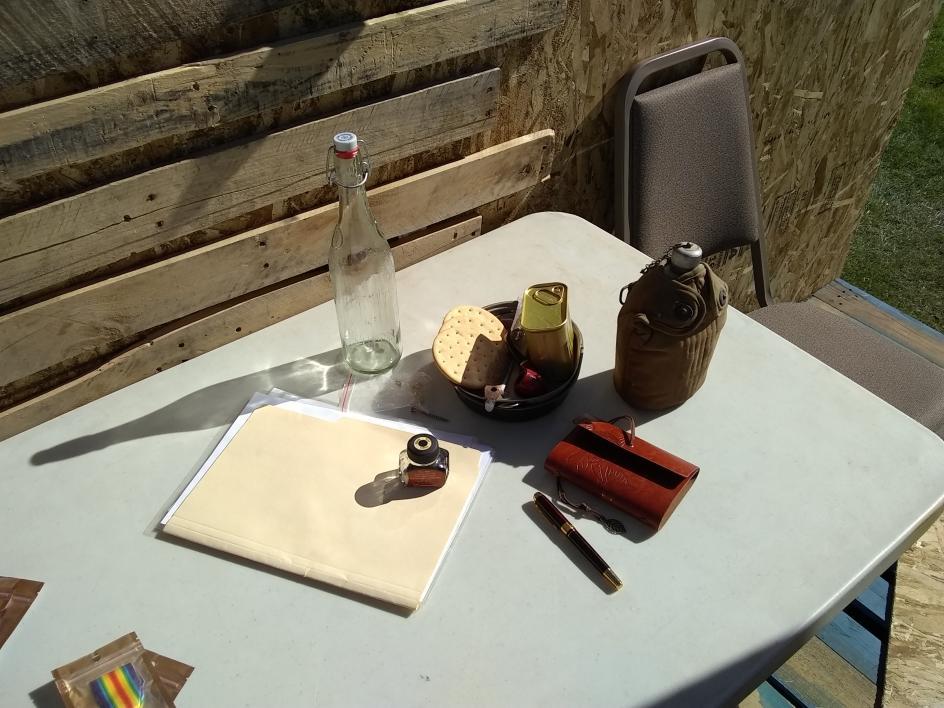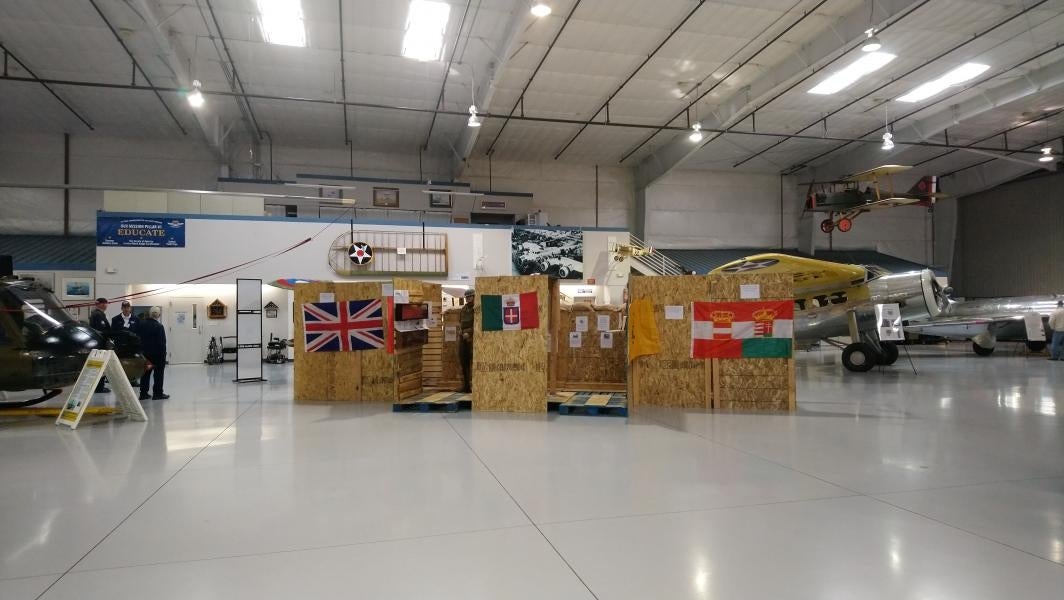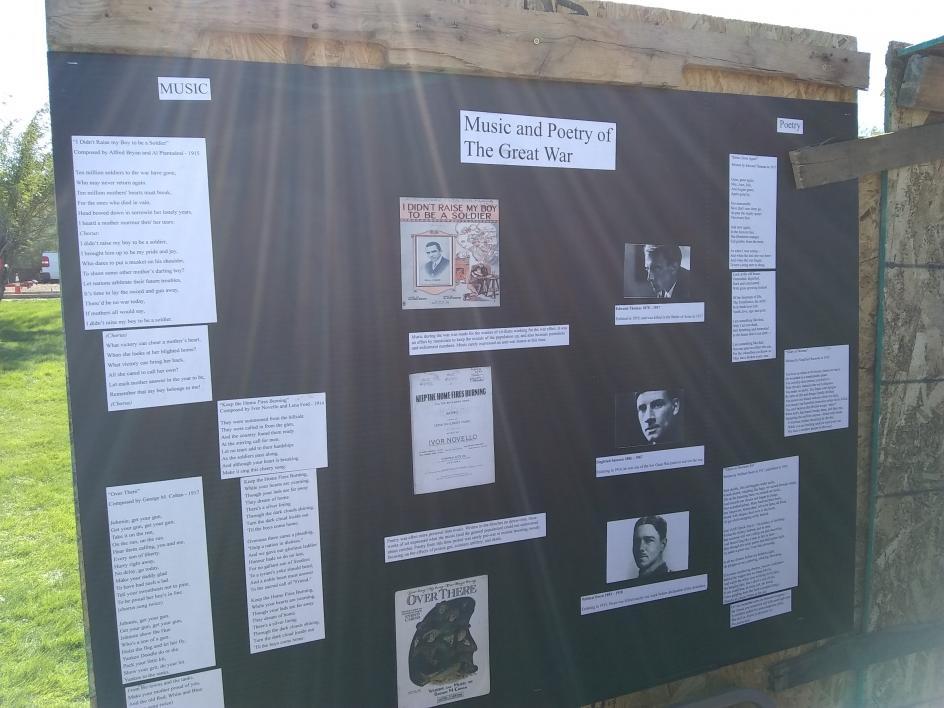ASU Polytechnic campus junior thriving in the trenches of history

ASU Polytechnic campus history major Scott Hilbrands manned the WWI trench exhibit that the Poly History Club students produced. The exhibit was displayed for a week at the Arizona Commemorative Air Force Museum at Falcon Field.
If you’ve been looking for Arizona State University history major Scott Hilbrands at his usual haunts on the ASU Polytechnic campus this week, you’ll find him instead a few miles north — surrounded by sandbags at Mesa’s Falcon Field.
Hilbrands, a junior and president of the new Poly History Club, has been manning the club’s impressive WWI trench exhibit that is on display at the Arizona Commemorative Air Force Museum at Falcon Field. The exhibit continues through Saturday, Jan. 26.
The installation gives visitors a chance to imagine what prolonged time in a WWI trench might be like, while perusing artifacts and reading about the era.
For Hilbrands, the experience of working to research and produce the exhibit and bring history alive for others lines up precisely with the dreams he has for his future.
“I want to use my degree to not only preserve history but to help promote it to the public, whether that is through being a tour guide, archivist, college professor or historian,” said Hilbrands, dressed in the full regulation American WWI uniform that the club purchased. “Getting people to realize that history is as vital to the world as math and science — and as exciting — is a dream of mine.”
The club members built the exhibition in October and November for the History Pop-Up Museum that students enrolled in history courses at ASU’s Polytechnic campus curate each semester.
ASU Polytechnic campus history faculty member Valerie Adams, who volunteers at the Arizona Commemorative Air Force Museum each week, interested the museum in showcasing this student work.
“It was originally scheduled to just run one day, on the Martin Luther King Jr. holiday, Monday, Jan. 21,” Adams said. “But due to the popularity of the exhibit, the museum director decided to extend it to a full week.”
“When the museum director invited our club to display the exhibit, I was ecstatic to say the least — I used to go to Falcon Field a lot when I was young,” Hilbrands said. “Things had to come together pretty quickly, though.
“Most of my crew was either out of town for MLK Day or had jobs they had to work, but with the help of fellow student Trenton Clark and some of Falcon Field's volunteers, we assembled the display on Monday morning and I got into my uniform and began giving tours,” he said.
“Most of the visitors this week have been military veterans whose service has ranged from WWII to Vietnam, Air Force to Special Forces, and talking with them has been a great honor and learning experience,” continued Hilbrands. “Many have shared experiences from their service or talked about the sympathy they feel for the men and women who endured WWI. Some mentioned seeing the scars of the trenches when visiting Europe and how they saw people still finding un-detonated bombs and shells.”
Using technology of the future to enliven the past
Learning more about The Great War and going deeper into history in general have long been a passion for Hilbrands.
“The Great War wasn't really taught that well in my junior high or high school — it seemed we read four to five pages that briefly talked about the war. It was World War II that we’d have the greatest discussion on. I began to develop a curiosity about why we had a second world war — and an interest in all the repercussions up to the present,” he explained.
The more he read about WWI and the conflicts and events leading up to it, the more that passion grew.
“When I approached Dr. Adams about possibly doing an event to mark the 100th anniversary of Armistice Day, she gave me the idea of starting a group to help promote history to the public — and the Poly History Club was born,” said Hilbrands.
With encouragement from College of Integrative Sciences and Arts professor Eric Nystrom, co-director of ASU Public History, Hilbrands wrote a proposal for an ASU Public History grant to fund the WWI trench exhibit.
“Upon approval, I gathered a small team and we began exhibit construction, as we only had a month to design, build and improve,” he said.
The pallets used for the floor were donated by Bullseye Wholesale. Many of the books, flags, sandbags, equipment and medals where purchased from Amazon. The 1912 officers' manual, 82nd Division American doughboy helmet and periscope were purchased on Ebay.
“Most of the construction material for the trench, a miniature version of a British Mark IV tank and 75mm artillery gun came from Home Depot,” Hilbrands noted, “and some parts we had to make on a 3D printer. The technology of the future helps make the past more lively and engaging.”
When the History Club revealed their display at the History Pop-Up Museum on Nov. 13, 2018, they had more than 325 visitors.
“Many were high school or junior high students, and they were excited to use the periscope to view the tank, or take pictures of all the displays created by some of Dr. (Brooks) Simpson's WWI classMost of the crew who worked on the project were part of Simpson's class.,” recalled Hilbrands. “The kids asked us about certain battles, or what kind of planes were used in WWI and many other questions. We were prepared to answer to our best, but also to offer them a little bit of mystery, trying to induce them to solve the question themselves and spark a bit of enthusiasm to engage in history.”
Like any seasoned tour guide, the enthusiastic, budding historian delights in being able to share some of the details that have surprised him in doing all his WWI research.
“Some of the figures that came out of the trenches are still popular to this day. One Canadian regiment had a bear as a mascot, named Winnie. Winnie would later be donated to the London Zoo, where A.A. Milne would be inspired by that same bear to create ‘Winnie-the-Pooh,’” shared Hilbrands. “An ambulance driver from the Red Cross who ferried Allied soldiers to the closest hospital and was fascinated by cartoons, that was Walt Disney. Despite studying WWI over the past few years, stumbling across new information about it still reinforces my passion for history.
“I’m proud to be a history lover, an ASU student and to help serve my community in engaging in history,” he said, “as it still affects us to this day and will affect how we shape our future."
More Arts, humanities and education

ASU’s Humanities Institute announces 2024 book award winner
Arizona State University’s Humanities Institute (HI) has announced “The Long Land War: The Global Struggle for…

Retired admiral who spent decades in public service pursuing a degree in social work at ASU
Editor’s note: This story is part of coverage of ASU’s annual Salute to Service.Cari Thomas wore the uniform of the U.S. Coast…

Finding strength in tradition
Growing up in urban environments presents unique struggles for American Indian families. In these crowded and hectic spaces,…





